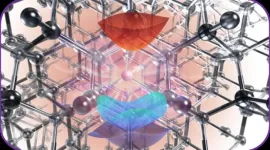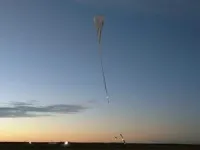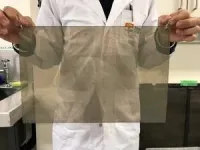(Press-News.org) Researchers at the University of Chicago’s Pritzker School of Molecular Engineering (PME), Argonne National Laboratory, and the University of Modena and Reggio Emilia have developed a new computational tool to describe how the atoms within quantum materials behave when they absorb and emit light. The tool will be released as part of the open-source software package WEST, developed within the Midwest Integrated Center for Computational Materials (MICCoM) by a team led by Prof. Marco Govoni, and it helps scientists better understand and engineer new materials for quantum technologies.
“What we’ve done is broaden the ability of scientists to study these materials for quantum technologies,” said Giulia Galli, Liew Family Professor of Molecular Engineering and senior author of the paper, published in Journal of Chemical Theory and Computation. “We can now study systems and properties that were really not accessible, on a large scale, in the past.”
Galli’s group showed the accuracy of the tool, known as WEST-TDDFT (Without Empty States - Time-Dependent Density Functional Theory), in studying three different semiconductor-based materials but said it can be applied to a wide range of related materials and the software that has been developed can run at scale on multiple high-performance architectures.
The building blocks of quantum information
The fundamental units of information underlying new, powerful quantum technologies are qubits. Unlike the bits used in classical computing, which use only 0s and 1s to encode data, qubits can also exist in states of superposition, representing both 0 and 1 simultaneously.
Miniscule defects within materials — such as a missing or substituted atom in the structured lattice of a crystal — can take on quantum states and be used as qubits. These qubits are extremely sensitive to the electric, optical, and magnetic properties of their surroundings, giving them the ability to be used as sensors. Understanding exactly how these “point defects” interact with photons of light to change their energy states can let researchers better manipulate them or design materials that use the qubits as sensors or data-storage units.
“How these materials are absorbing and emitting light is critical to understanding how they are functioning for quantum applications,” said Galli. “Light is how you interrogate these materials.”
Until now, researchers could predict both the absorption and the emission of light by point defects, but could not fully explain some of the atomic processes that happened within the material while in its excited state, especially in the case of large and complex systems.
Streamlining complex calculations
The quantum mechanical equations that must be solved to determine the atomic properties of materials are incredibly complex and require a large amount of computing power. In the new work, Galli’s team encoded a new way of solving such equations more efficiently than in the past while proving that they were still accurate. The increased speed and efficiency at which the equations can now be solved means that they can be applied more easily to larger systems — in the past, the computing time and power required to analyze these systems made it unfeasible.
“With these methods, we can study the interaction of light with materials in systems that are quite large, meaning that these systems are closer to the experimental systems actually being used in the laboratory,” said graduate student Yu Jin, the first author of the new paper.
The efficient approach developed by the team can run on two different computer architectures — central processing units (CPUs) and graphics processing units (GPUs). The researchers used it to study the excited state properties of point defects within three materials: diamond, 4H silicon carbide, and magnesium oxide. They found that the tool could effectively calculate the properties of these systems even when they had hundreds or thousands of atoms.
A broader goal
The MICCoM team developing WESTincludes Dr. Victor Yu, Yu Jin, and Prof. Marco Govoni. The group is continuing to apply and finetune the algorithms available in the package, including WEST-TDDFT, to study broad classes of materials, not only for quantum technologies but also for low power and energy applications.
“We’ve found a way to solve the equations describing light emission and absorption more efficiently so that they can be applicable to realistic systems,” said Govoni. “We showed that the method is both efficient and accurate.”
The new tool fits with the broader goal of the Galli lab to study and design new quantum materials. Also, this month, they published new results showing how spin defects close to the surface of a material behave differently than those deeper within a material, depending on how the surface is terminated. Their results have implications for the design of quantum sensors that rely on spin defects.
The team also had a recent paper, published December 9 in npj computational materials, examining the properties of ferroelectric materials being used in neuromorphic computing.
Citation: “Excited State Properties of Point Defects in Semiconductors and Insulators Investigated with Time-Dependent Density Functional Theory,” Jin et al., Journal of Chemical Theory and Computation, 19(23), 8689–8705, December 1, 2023. DOI: acs.jctc.3c00986
Funding: This work was supported by the Midwest Integrated Center for Computational Materials (MICCoM), which is funded through the U.S. Department of Energy. The work also used the resources of the National Energy Research Scientific Computing Center (NERSC) and the University of Chicago Research Computing Center.
END
Advanced computational tool for understanding quantum materials
2023-12-21
ELSE PRESS RELEASES FROM THIS DATE:
Role of enzyme SMYD3 clarified in prostate cancer progression
2023-12-21
Prostate cancer is the most common cancer in men other than skin cancer, and more than 288,000 new cases are diagnosed every year, according to the American Cancer Society. The disease’s fatality rate has decreased by more than half since the 1990s, but there is still room for progress—especially in treating or preventing advanced, metastatic disease, which is much more likely to be fatal.
A new paper published in Science Advances clarifies how an enzyme called SMYD3 may be involved in prostate ...
Professor Vladimir A. Botchkarev, Boston University School of Medicine, receives Skin Ageing & Challenges Best Scientific Award 2023
2023-12-21
The Skin Ageing & Challenges 2023 conference, held in November 2023 in Lisbon, has recognized the outstanding contributions of Prof. Vladimir A. Botchkarev, a distinguished Professor of Dermatology and Co-Director at the Boston University Center for Aging Research, with the prestigious Skin Ageing & Challenges Best Scientific Award 2023. The award acknowledges Prof. Botchkarev's exceptional research in the field of skin biology and aging.
Prof. Botchkarev's award-winning work, titled "Skin Aging in Long-Lived Naked Mole-Rats: Mechanisms and Perspectives", delves into the complicated aging process of Naked Mole Rats' skin. His comprehensive ...
Save the date for the 11th World Congress on Targeting Microbiota 2024 – Revolutionizing Future Medicine
2023-12-21
Targeting Microbiota 2024: Vision, Strategies and Perspectives
The 11th Annual Congress of the International Society of Microbiota (ISM), Targeting Microbiota 2024, is scheduled on October 17-18, at Corinthia Palace Malta. Targeting Microbiota 2024 will not only present the latest advancements but also serve as a pivotal hub for sharing visionary strategies and perspectives that will redefine the landscape of medicine. The Congress promises an immersive experience, offering a dynamic platform for the exchange of ideas, insights, and the exploration of innovative approaches that will shape the future of medicine.
Save the date and ...
Location, location, location: The hidden power of intracellular neighborhoods
2023-12-21
Highlights
Messenger RNA (mRNA) is translated into proteins in the cytoplasm of cells. But rather than being a uniform “soup,” the cytoplasm is divided into multiple distinct compartments or regions.
Each region is largely responsible for translating functionally similar types of mRNA, a new MSK study finds. And the location of translation determines the amount of protein produced by the mRNA.
The movement of mRNA to specific regions is directed by their size and shape, as well as by RNA-binding protein partners.
The findings could help develop new approaches to increase ...
Better prosthetics: $3M to develop more natural robotic leg control
2023-12-21
Dec. 21, 2023
Contact: Nicole Casal Moore, 734-709-1651, ncmoore@umich.edu
Images and videos
Better prosthetics: $3M to develop more natural robotic leg control
An effort to create a control model that moves seamlessly between different activities like standing, walking and climbing stairs is renewed by the National Institutes of Health
ANN ARBOR—A smoother experience for robotic prosthetic leg users is the aim of a University of Michigan project that has received renewed support from the National Institutes of Health. The R01 grant ...
The Council of Medical Specialty Societies awards CHEST a $100,000 grant to improve diagnostic excellence in ILD
2023-12-21
Glenview, IL – The American College of Chest Physicians (CHEST) was awarded a $100,000 grant from the Council of Medical Specialty Societies (CMSS) to improve diagnostic excellence in interstitial lung disease (ILD).
The funded project, called, "'How We Do It': CHEST Experts Weigh In," aims to inform future best practices in reducing the time to diagnosis for ILDs. The activities in the series will prepare the learner to:
define symptoms and patient profiles associated with ILD;
recognize health inequities that may assist in the diagnosis of ILD;
identify the appropriate tests that may help validate a suspicion of ILD; ...
Center for BrainHealth investigates the impact of auditory beat stimulation on cognition
2023-12-21
Certain Frequencies Enhance Comprehension
New research conducted by the Center for BrainHealth at The University of Texas at Dallas investigates the impact of binaural beat (BB) on language skills. BB is a sound that occurs when two slightly mismatched pure tones are heard. There is a growing interest in using BB as a non-invasive neuromodulation to enhance cognitive performance.
The study, Neural consequences of binaural beat stimulation on auditory sentence comprehension: an EEG study, was recently published in Cerebral Cortex.
Led by researchers in the Speech, Language and Music (SLAM) Lab, this EEG ...
Where you live matters: A first-of-its-kind study illustrates how racism is interrelated with poor health
2023-12-21
Where You Live Matters: A First-of-Its-Kind Study Illustrates How Racism Is Interrelated With Poor Health
Study published in JAMA Network Open points to discrete factors, like voting participation, employment, education, and housing, that may serve as promising targets for interventions
New York, NY (December 21, 2023) – A team of health equity researchers from several institutions has leveraged a complex web of data to test a hypothesis: That structural racism is associated with resources and structures at the neighborhood level that are closely associated with poor health. What they found in an analysis of highly localized, ...
New tool unifies single-cell data
2023-12-21
A new methodology that allows for the categorisation and organisation of single-cell data has been launched. It can be used to create a harmonised dataset for the study of human health and disease.
Researchers at the Wellcome Sanger Institute, the University of Cambridge, EMBL’s European Bioinformatics Institute (EMBL-EBI), and collaborators developed the tool, known as CellHint. CellHint uses machine learning to unify data produced across the world, allowing it to be accessed by the wider research community, potentially driving new discoveries.
In a new study, ...
Pancake stack of films on a balloon most accurate gamma-ray telescope
2023-12-21
A pancake stack of radioactivity-sensitive films carried through the sky by a balloon was able to take the world's most accurate picture of a neutron star's gamma ray beam. To achieve this, Kobe University researchers combined the oldest method of capturing radioactive radiation with the newest data capturing techniques and a clever time-recording device.
The stars shine their light on us in the full range of the spectrum of light, from infra-red to gamma rays. For each of these bands, different sensing equipment is needed. The most challenging one is gamma rays, famous for being a high-energy product of nuclear fission, ...






